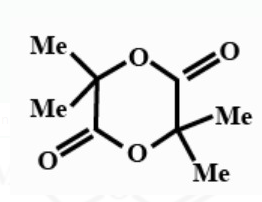a) Compound (A) C8H12 on oxidation gives an acid (B) C4H6O2. One molecule of compound (A) reacts with 3 mole of H2 in presence of platinum catalyst to give octane. Identify compound (A).

The number of carbon atoms (C8) in (A) is twice the number of carbon atoms (C4) in acid (B). So 2 mole of acid C4H6O4 join with each other to give the compound (A).

Since, the cyclopropane ring is highly strained ring, so on catalyst hydrogenation, 3 moleof H2 are required i.e., one mol for each of cyclopropane ring and one mol for reducing the (C=C) bond.
b) 
So,2 mole of each of the products C3 are obtained by oxidation of (A). Two (C=O) groups of two acetone are joned with two (C=O) groups of dicarboxyclic acid and then removing the oxygen atoms and joining the carbon atoms with double bonds gives the structure of compound (A) 
Topper's Solved these Questions
- UNSATURATED HYDROCARBONSBOOK - OP TANDONCHAPTER - UNSATURATED HYDROCARBONSEXERCISE - Match type
1 Videos
- UNSATURATED HYDROCARBONSBOOK - OP TANDONCHAPTER - UNSATURATED HYDROCARBONSEXERCISE - PROBLEMS BASED ON STRUCTURE AND PROPERTIES
10 Videos
- UNSATURATED HYDROCARBONSBOOK - OP TANDONCHAPTER - UNSATURATED HYDROCARBONSEXERCISE - SOME SOLVED PROBLEMS
31 Videos
- STOICHIOMETRY (CHEMICAL FORMULAE AND EQUATIONS )BOOK - OP TANDONCHAPTER - STOICHIOMETRY (CHEMICAL FORMULAE AND EQUATIONS )EXERCISE - SELF ASSESSMENT
11 Videos
Similar Questions
Compound (A)(C8H12) on oxidation gives an acid B(C4H6O2). One mole of compound (A) reacts with 3mol of H2 in the presence of Pt catalyst to give octane. Identify compound (A).
View SolutionCompound (A)(C8H12) on oxidation gives an acid B(C4H6O2). One mole of compound (A) reacts with 3mol of H2 in the presence of Pt catalyst to give octane. Identify compound (A).
View Solution
Knowledge Check
The compound X(C3H6O) on oxidation gives a compound Y(C3H6O2) . The compound Y is
Apropanoic acidBbutyric acidCacetic acidDpropenoic acid
The compound F(C6H12O) on oxidative ozonolysis yirlds acetic acid and a compound (G) (C4H8O3). The new compound (G) on heating gives:A BMe−CH=C=CH−EtC
BMe−CH=C=CH−EtC D
D
Compound 'A' with the formula C3H8O on vigorous oxidation produces an acid C3H6O2. 'A' is
Aa tertiary alcoholBa secondary alcoholCa primary alcoholDnot necessarily an alcohol
Compound (A)(C12H16) on oxidation with acidic KMnO4 solution gives acetone and
 . Identify compound (A).
. Identify compound (A).
View SolutionCompound (A)(C12H16) on oxidation with acideic KMnO4 solution gives acetone and
 . Identify compound (A).
. Identify compound (A).
View SolutionAn organic compound A (C7H6Cl2) on treatment with NaOH solution gives another compound B (C7H6O). B on oxidation gives and acid C (C7H6O2) which on treatment with a mixture of conc. HNO3 and H2SO4 gives a compound D (C7H5NO4). B on treatment with conc. NaOH gives a compound E (C7H8O) and C6H5COONa. Deduce the structures of [A], [B], [C], [D] and [E].
View SolutionCompound (A) C8H9Br. Gives a white precipitate when warmed with alcoholic AgNO3. Oxidation of (A) gives an acid (B). C8H6O4. (B) easily forms anhydride on heating. Identify the compound (A)
View SolutionCompound (A) C8H9Br, gives a white precipitate when warmed with alcoholic AgNO3. Oxidation of (A) gives an acid (B),C8H6O4. (B) easily forms anhydride on heating. Identify the compound (A)
View Solution
